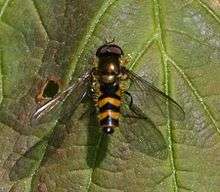Melangyna cincta
Melangyna cincta is a European species of hoverfly. This species has a muddled taxonomic history. Stubbs & Falk treat it as a member of the genus Melangyna. Other sources place it in Meligramma (as either a separate genus or a subgenus of Melangyna) or Fagisyrphus.[1]
| Melangyna cincta | |
|---|---|
 | |
| Melangyna cincta (male) | |
| Scientific classification | |
| Kingdom: | |
| Phylum: | |
| Class: | |
| Order: | |
| Family: | |
| Subfamily: | |
| Tribe: | |
| Genus: | |
| Species: | M. cincta |
| Binomial name | |
| Melangyna cincta (Fallén), 1817 | |
Description
External images
For terms see Morphology of Diptera
Wing length 6 ·25–8·75 mm. Tergites 3 and 4 with yellow to orange bands. Tergite 2 with two yellow, triangular marks. Elongate abdomen.
See references for determination.[2]
[3]
[4]
[5]
The male genitalia are figured by Dusek and Laska (1967).[6] The larva is figured in colour by Rotheray (1994).[7]
Distribution
Palearctic Fennoscandia South to Iberia and the Mediterranean. Ireland Eastwards through Europe into European Russia, the Crimea and Turkey. [8][9]
Biology
Habitat: Fagus and Quercus woodland.[10] Flowers visited include white umbellifers, Acer pseudoplatanus, Crataegus, Ligustrum, Malus sylvestris, Prunus spinosa, Rubus idaeus, Salix, Sambucus nigra, Sorbus aucupariae, Urtica dioica, Viburnus opulus.[11] The flight period is April to July in two generations. The larva feeds on aphids.
References
- Stubbs, Alan E. & Falk, Steven J. (1983). British Hoverflies: An Illustrated Identification Guide. British Entomological & Natural History Society.
- Van Veen, M. (2004) Hoverflies of Northwest Europe: identification keys to the Syrphidae. 256pp. KNNV Publishing, Utrecht.addendum
- Van der Goot,V.S. (1981) De zweefvliegen van Noordwest - Europa en Europees Rusland, in het bijzonder van de Benelux. KNNV, Uitgave no.32: 275pp. Amsterdam.
- Bei-Bienko, G.Y. & Steyskal, G.C. (1988) Keys to the Insects of the European Part of the USSR, Volume V: Diptera and Siphonaptera, Part I. Amerind Publishing Co., New Delhi. ISBN 81-205-0080-6.
- Coe, R.L. (1953) Diptera: Syrphidae. Handbks.ident.Br.insects, 10(1): 1-98. R.ent.Soc.London. pdf
- Dusek, J. & Laska, P. (1967) Versuch zum aufbau eines Naturlichen Systems mitteleuropaischer Arten der Unterfamilie Syrphinae (Diptera). Acta sc.nat.Brno, 1: 349-390.
- Rotheray G., 1993 Colour Guide to Hoverfly Larvae Diptera, Syrphidae in Britain and Europe Dipterists Forum pdf
- Fauna Europaea
- Peck, L.V. (1988) Syrphidae. In: Soos, A. & Papp, L. (eds.) Catalogue of Palaearctic Diptera, 8: 11-230. Akad.Kiado, Budapest.
- Speight, M.C.D. (2011). "Species accounts of European Syrphidae (Diptera)" (PDF). Syrph the Net, the database of European Syrphidae. 65: 285pp.
- de Buck, N. (1990) Bloembezoek en bestuivingsecologie van Zweefvliegen (Diptera, Syrphidae) in het bijzonder voor België. Doc.Trav. IRSNB, no.60, 1-167.